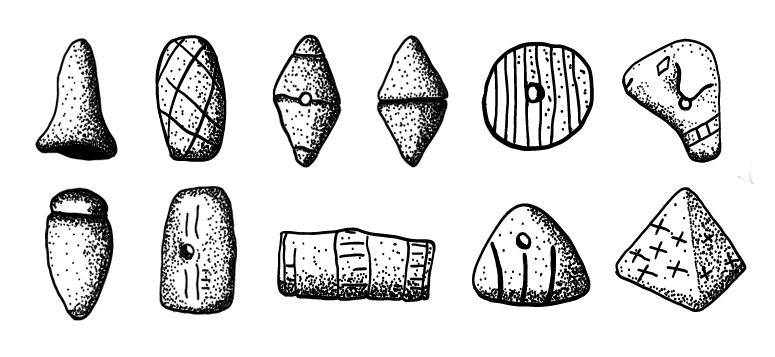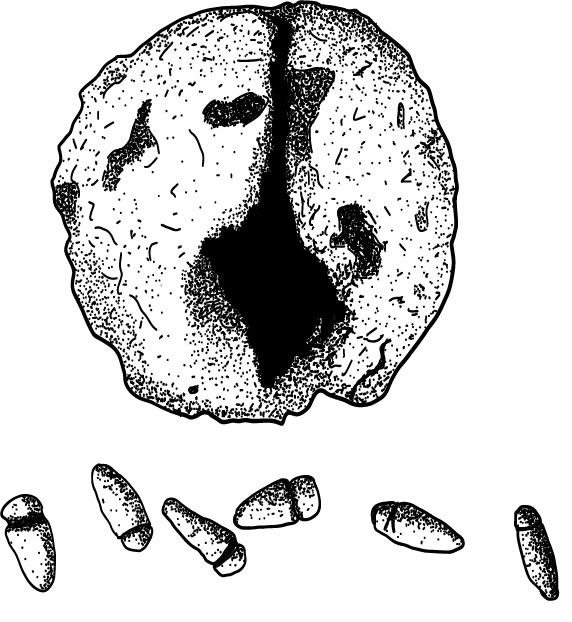The origins of accounting
Summary: The origins of accounting are uncertain, various, and remain a mystery in parts of the world. However, one tantalising theory for its development in Western culture begins in Mesopotamia and is tied up with the invention of agriculture.

The history of accounting is deeply entwined with the history of money, but possibly not in the way you might expect. If you were to place accounting in the history of humanity, when would it appear? A plausible story, commonly told but incorrect, is that the need for money arose from the limitations of barter economies. In this version of history, money was necessary to drive the increasing sophistication of trade, which later led to the development of credit. [Note 1]
A more probable thread in the complex web of the origins of accounting coincides with the invention of agriculture in the ancient Near East about 12,000 years ago.
Before accounting
According to scientists, humans, in their current form as Homo sapiens, have been around for about 300,000 years. Not very long in planetary, geological, or biological terms. Put another way, if planet Earth’s existence was represented as a single year, Homo sapiens would have been around for the last 30 minutes.
For 97% of that time, 290,000 years, these humans lived in small groups sustaining themselves primarily through foraging and a little hunting. They lived in good health and relative abundance, moving from place to place, carrying few possessions and feeding from various and plentiful seasonal foods.
It’s difficult to imagine these foraging ancestors experiencing the same emotions, passions, and fears that we do. But it seems very likely — those first Homo sapiens looked like us, with the same traits and abilities. Some evidence hints that they were better fed, physically stronger, intellectually superior, and enjoyed more free time than the average modern person.
This seems plausible given that, to survive, every ancient forager required considerable knowledge and skills. Today, by contrast, each of us relies to a much greater extent on others. Accessing even the basics of security, shelter, warmth, transport, food, and water depend on a complex web of organisations and expertise beyond the understanding of any single individual.
Forager communities likely had little need for accounting as their livelihoods were largely subsistence-based, with perhaps occasional exchange with neighbouring or passing communities. It is also probable that these societies functioned entirely successfully without numbers or writing. Not because they couldn’t grasp the ideas but because their way of life didn’t require it.
The agricultural revolution
About 12,000 years ago, Homo sapiens started to give up foraging and take up farming instead. Populations grew so fast that, even if they chose to, humans could never return to hunter-gatherer mode. Farming significantly changed not only the way that humans lived but also how they thought. In the words of Yuval Noah Harari, the agricultural revolution was “the foundation of large-scale political and social systems”. [Note 2].
The new social structures required far-reaching cooperation and, therefore, rules that could be widely enforced. Laws alone were not enough to establish control. Keeping records, or what we now call book-keeping, was vital to track products and determine how to allocate resources among community members.
In the ancient Near East, numerals were probably first invented by accountants in about 3100 BCE, evidenced by impressions made in wet clay—cuneiform tablets. But this leaves a gap of 9,000 years from the birth of the agricultural revolution to the first objects of writing.
Denise Schmandt-Besserat, a French archaeologist working from the 1960s to the 1990s, developed an ingenious theory of how writing developed during this period. Not all experts endorse her conclusions, so caution is required, but the broad direction she outlines is compelling.
The first bookkeepers
Archaeologists uncovered small clay-fired objects in the Mediterranean and ancient Near East. They first appeared around 8000 BCE, just as social structures and states were emerging, and more frequently in cities including Uruk in Sumer (in modern-day Iraq) and Susa (in modern-day Iran, possibly a colony of Uruk and certainly within its cultural sphere).
These tokens were carefully modelled into simple shapes, including cones, spheres, cylinders, ovoids, triangles, vessels, tools and animals. Some were plain, while others were marked or punctuated.

Archaeologists have been aware of these objects since the late nineteenth century but, until Schmandt-Besserat’s work, failed to explain their use in detail. She tells of reading one report of “mysterious conical clay objects, looking like nothing in the world but suppositories. What they were used for is anyone’s guess”. [Note 3]
Schmandt-Besserat proposed that the tokens were used for communication and record-keeping. Initially, as a form of one-to-one correspondence: “one jar of oil was shown by one ovoid, two jars of oil by two ovoids”. An incised cone signified bread and rhomboids accounted for quantities of beer.
This elaborate reckoning system enabled administrators to account for, allocate and ration quantities of animals, crops and produce. There is an inference that “tokens were a means of controlling goods in the hands of powerful administrators”. [Note 4] The notion that accounting can be used to coerce and control is not new.
And when we consider the first uses to which writing was put, it would seem quite clear that it was connected first and foremost with power: it was used for inventories, catalogues, censuses, laws and instructions; in all instances, whether the aim was to keep a check on material possessions or on human beings, it is evidence of the power exercised by some men over other men and over worldly possessions.
Claude Lévi-Strauss, cited by Schmandt Besserat (1992)
The link between tokens and numbers
Tokens were a perfectly workable solution on their own, although, by the fourth millennium BCE, strings of tokens and envelopes (hollow clay balls to hold tokens) were being used. The advantage of envelopes might have been the ability to mark collections of tokens with a seal of authority.
Once inside an envelope, however, the enclosed tokens were hidden. Schmandt-Besserat explains, “Accountants resolved the problem by imprinting the shapes of the tokens on the surface of the envelopes prior to enclosing them”. Some envelopes bear impressions of the enclosed tokens, while others show thumbnail, stick, or stylus markings.


From approximately 3500 BCE, the hollow token-filled envelopes were replaced with solid clay balls bearing markings. The fourth Millennium accountants realised that the tokens themselves were not necessary. They began substituting the tokens for signs of tokens, a first step toward writing.
The use of clay was significant. It was abundant and easy to manipulate when wet, making it possible for “bookkeepers” with little skill and without tools to create tokens. Importantly, the recording device became permanent when dried or baked. Its fragility might have served as a guarantee of authenticity and it would be difficult to change a record without leaving some evidence, like chips or worse. Sumerian blockchain, if you like.
From bookkeeping to literature
Schmandt-Besserat goes on to make two significant observations. Firstly, although these symbols were pictographs, they were not pictures of the items they represented but pictures of the tokens used in the earlier accounting system. Secondly, this evolved into a system whereby the thing counted and the number indicating quantity were separated. One type of sign represented the commodity, and another expressed abstract numbers or cardinality. In her words:
The most important evidence uncovered is that counting was not, as formerly assumed, subservient to writing but, on the contrary, writing emerged from counting.
Once the scribes got busy expertly poking and scraping reeds into soft clay, a script called cuneiform was established, which marked the beginning of the writing systems we use today. If we accept Schmandt-Besserat’s theories, we can surmise that all Western literature and historical records are rooted in the origins of accounting and relied on writing skills first developed by Sumerian accountants.
Resources, references and further reading
[Note 1] Economists describe money as solving the problem of ‘finding a double coincidence of wants’. They imagine a barter system where two parties can only trade when each wants what the other offers. There is very little evidence that barter economies were significant anywhere and plenty of evidence that they weren’t. For a more detailed explanation, read David Graeber’s Debt: The First 5,000 Years, Chapter 2: The Myth of Barter.
[Note 2] Harari, Y. N. (2011) Sapiens: A Brief History of Humankind, pp 113–114. Penguin.
[Note 3] Schmandt-Besserat, D. (1992) Before Writing, Volume I, From Counting to Cuneiform, p 8. University of Texas Press.
[Note 4] Schmandt-Besserat, D. (1992) Before Writing, Volume I, From Counting to Cuneiform, p 129. University of Texas Press.
© AccountingCafe.org
Part of the Concepts series
Join the Accounting Cafe community




It’s humbling and gives me thrills and shivers to think about our connection with our “30-minutes-ago forebears. And how accounting and proto-bookkeeping links us so simply to those early-agriculture times.
I love this article! I would aks my students to:
1. Instead of spheres and cones you are being asked to design new tokens. What design would you make? And why?
2. The origin of accounting speaks of a record of valuable items (mainly food).
What do you consider valuable? And what would be the lowest value and what the highest in your new value system? (A while ago some regarded Pokemon go cards as extremely valuable)
3. Some say we use a ‘digital’ system (1-10 because we humans have 10 digits). Can you imagine a world, or a species that would use a different number system? What would that system look like?